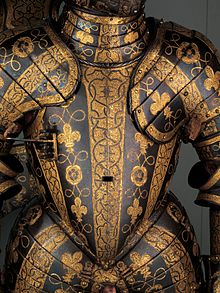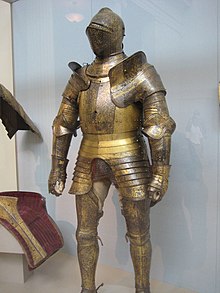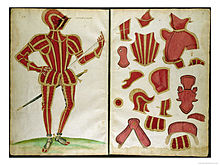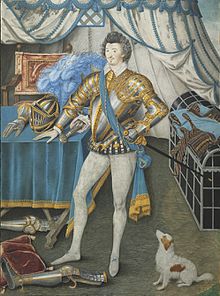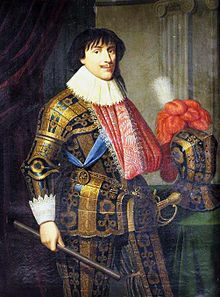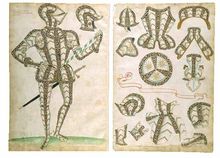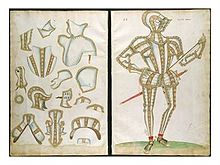
Jousting is a medieval and renaissance martial game or hastilude between two combatants either on horse or on foot. The joust became an iconic characteristic of the knight in Romantic medievalism.

Plate armour is a historical type of personal body armour made from bronze, iron, or steel plates, culminating in the iconic suit of armour entirely encasing the wearer. Full plate steel armour developed in Europe during the Late Middle Ages, especially in the context of the Hundred Years' War, from the coat of plates worn over mail suits during the 14th century.

Cuirassiers were cavalry equipped with a cuirass, sword, and pistols. Cuirassiers first appeared in mid-to-late 16th century Europe as a result of armoured cavalry, such as men-at-arms and demi-lancers discarding their lances and adopting pistols as their primary weapon. In the later part of the 17th century, the cuirassier lost his limb armour and subsequently wore only the cuirass, and sometimes a helmet. By this time, the sword or sabre had become his primary weapon, with pistols relegated to a secondary function.

Thomas Sackville, 1st Earl of Dorset was an English statesman, poet, and dramatist. He was the son of Richard Sackville, a cousin to Anne Boleyn. He was a Member of Parliament and Lord High Treasurer.

The great helm or heaume, also called pot helm, bucket helm and barrel helm, is a helmet of the High Middle Ages which arose in the late twelfth century in the context of the Crusades and remained in use until the fourteenth century. The barreled style was used by knights in most West European armies between about 1220 to 1350 AD and evolved into the frog-mouth helm to be primarily used during jousting contests.

Sir George Clifford, 3rd Earl of Cumberland, 13th Baron de Clifford, 13th Lord of Skipton,, was an English peer, naval commander, and courtier of Queen Elizabeth I of England. He was notable at court for his jousting, at the Accession Day Tilts, which were highlights of the year at court. Two famous survivals, his portrait miniature by Nicholas Hilliard and a garniture of Greenwich armour, reflect this important part of his life. In contrast, he neglected his estates in the far north of England and left a long succession dispute between his heirs.

William Compton, 1st Earl of Northampton, KG, known as 2nd Baron Compton from 1589 to 1618, was an English nobleman, peer, and politician.
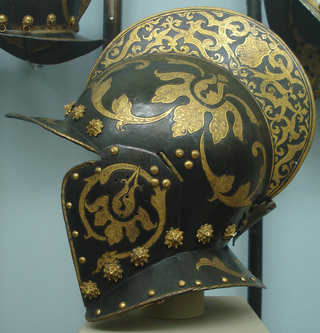
The burgonet helmet was a Renaissance-era and early modern combat helmet. It was the successor of the sallet.

Maximilian armour is a modern term applied to the style of early 16th-century German plate armour associated with, and possibly first made for the Emperor Maximilian I. The armour is still white armour, made in plain steel, but it is decorated with many flutings that may also have played a role in deflecting the points and blades of assailants and increasing the structural strength of the plates. It is a transitional stage in the decoration of armour, after the plain steel surfaces of 15th-century armour and before the elaborate decoration and colouring with etching and other techniques of Renaissance armour. The armour is characterized by armets and close helmets with bellows visors; small fan-shaped narrow and parallel fluting—often covering most of the harness ; etching; work taken from woodcuts; sharply waisted cuirasses, and squared sabatons.

The Accession Day tilts were a series of elaborate festivities held annually at the court of Elizabeth I of England to celebrate her Accession Day, 17 November, also known as Queen's Day. The tilts combined theatrical elements with jousting, in which Elizabeth's courtiers competed to outdo each other in allegorical armour and costume, poetry, and pageantry to exalt the queen and her realm of England.

The close helmet or close helm is a type of combat helmet that was worn by knights and other men-at-arms in the Late Medieval and Renaissance eras. It was also used by some heavily armoured, pistol-armed cuirassiers into the mid-17th century. It is a fully enclosing helmet with a pivoting visor and integral bevor.

Sir James Scudamore was a gentleman usher at the court of Queen Elizabeth I. Born at Holme Lacy, Herefordshire, he was the eldest son of John Scudamore, Custos Rotulorum of Herefordshire and his first wife Eleanor Croft, daughter of former Lord Deputy of Ireland James Croft. He would assume that title in 1616, and remained Custos Rotulorum for two years until his own death in 1619. Scudamore was respected for his tilting skill and his embodiment of the ideals of chivalry.

Laminar armour is an armour made from horizontal overlapping rows or bands of, usually small, solid armour plates called lames, as opposed to lamellar armour, which is made from individual armour scales laced together to form a solid-looking strip of armour. Prominent examples of such armour are lorica segmentata of Ancient Rome and certain versions of samurai armour.

Lorenz Helmschmied or "Helmschmid" was a German armourer and a member of the Helmschmied family of armourers from Augsburg. He was one of the primary armourers to the Habsburg court of the Holy Roman Emperors Frederick III and Maximilian I, and created some of the most technically innovative and artistically complex armours of the late-fifteenth and early-sixteenth centuries.

Sir Henry Lee KG, of Ditchley, was Queen's Champion and Master of the Armouries under Queen Elizabeth I of England.

The Earl of Pembroke’s Armour is one of the pieces in the Royal Ontario Museum’s European Collection. This suit of armour belonged to the Earl of Pembroke, William Herbert (1501-1570).
The Brocas helm is a jousting helm on display at the Rotunda as part of the Tower of London armoury collection. It was commissioned by an English knight from an Italian armourer.

The Royal Armoury of Turin is one of the world's most important collections of arms and armour, formed in Turin by the Savoy family. The museum is now part of the Musei Reali di Torino, the royal site that has unified the Royal Palace, the Sabauda Gallery, the Archaeological Museum, the Royal Library and the Armoury. The whole site has been included on the UNESCO World Heritage list since 1997.
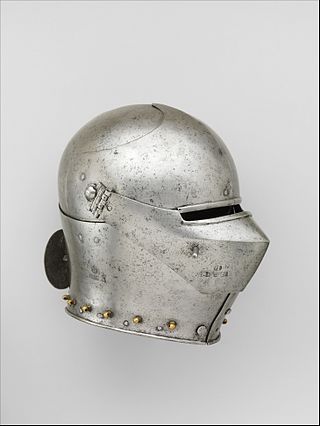
Funerary Helmets,Mortuary Helms, or Mort Helms were the major element of a suit of armour that was most often placed above or near the carved memorial effigy of the knights or members of the nobility concerned in a tradition that ran from at least the 14th through to the 17th century, particularly when the person concerned had gained a reputation in life as a warrior. These helmets were often brightly painted or otherwise ornamented with floral designs, etc. Largely located within rural churches and other religious buildings, the practice was especially common in the south-west English counties and Cornwall with only a few examples known from Scotland.
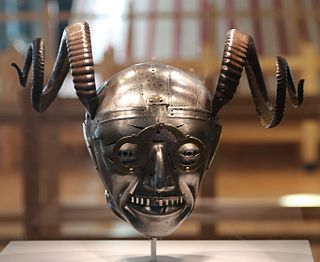
The horned helmet of Henry VIII is the surviving part of a full suit of armour made by Konrad Seusenhofer between 1511 and 1514. The armour was a gift from the Holy Roman Emperor Maximilian I to the English king Henry VIII, following their alliance in the War of the League of Cambrai. The suit was elaborate and intended for display at tournament parades. It is unclear who was the intended wearer of the armour, but it appears to have been modelled on one of Henry's court fools. Henry may have worn the armour as a jest. The helmet has protruding eyes and a toothy grimace and is adorned with horns and spectacles. The helmet survived when the rest of the suit of armour was scrapped, probably after the English Civil War, and it is now in the collection of the Royal Armouries Museum in Leeds, which formerly used it as a symbol of the museum.
